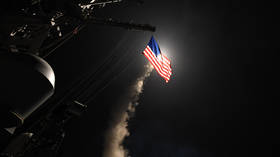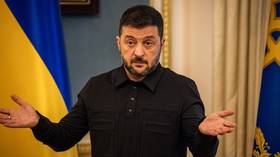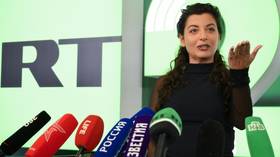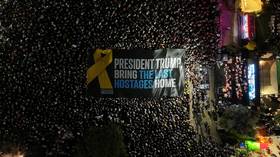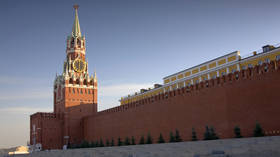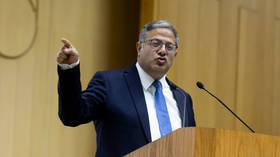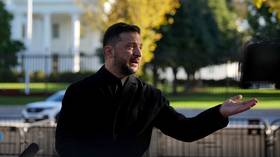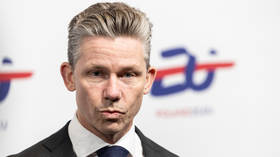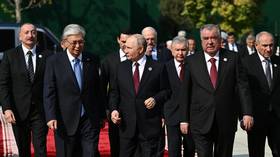When Tomahawks become boomerangs
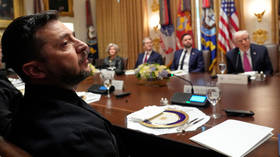
Leave it to Mr. Unpredictable, aka Donald Trump, President of the United States, to pack a policy U-turn, a harsh unfriending, and some fuzzy ambiguity into just a few days. As things stand now, Trump has said “no” to American Tomahawk cruise missiles for Kiev – maybe not yet forever, as his vice president J.D. Vance has stressed – but, clearly, for the foreseeable future, whatever that may mean with Trump.
In the process, he has also made it clear – painfully clear – that Kiev’s Vladimir Zelensky is back in the doghouse. Seemingly in favor for a while – after donning a suite like a good boy and flattering Trump at every opportunity and without inhibitions – the Ukrainian leader-without-elections is out in the cold again: No welcome at the airport; a Friday-afternoon meeting demonstratively scheduled to get a nuisance visitor out of the way before the weekend; and, we hear, some rough talk, even shouting, again.
It is as if Zelensky did not board a plane to pay another submission visit to Washington but a time machine. And it deposited him right back in February, when he received an urgently needed public drubbing in the Oval Office.
Compulsive optimists among the thinning crowd of deadly “friends”-of-Ukraine in the West may want to take solace in the fact that, this time, Trump had the decency to administer Zelensky’s spanking behind closed doors. But then, it was leaked immediately, to the Financial Times, no less.
Of course, the leaker may have been a desperate pro-Zelensky holdout still hiding somewhere in the US administration (that you, Keith Kellogg?), trying to alert the Europeans so they can come again to their Ukrainian protégé’s aid and sabotage the oh-so-horrible prospect of a quick peace. And according to Maria Zakharova, speaking for the Russian Ministry of Foreign Affairs, they have already started interfering again.
Lucky Ukrainians! You have a government that feeds you into a lost meatgrinder war for which your Western friends-from-hell once promised you NATO (Remember that one? Never mind, it was always a transparent lie) and now simply nothing. And you have diehard European “supporters” who fear nothing more than that this bloody scam will stop while some of you are still alive.
If the leak really came from someone attempting to sabotage Trump, we’ll hear about a dismissal soon. Come to think of it, the designated US delegation for Budapest does not seem to include Kellogg, as it happens. Yet we probably will not, because the better explanation is that it came from the very top and was meant to make Zelensky’s crash just as public as last time.
Finally, with the “forget-about-it” on the Tomahawks and the big, bruising unfriending, came the message on how to end the war. This time, Trump had no time for silly fairytales about Kiev still turning it around and winning. His blunt message was that Kiev must make concessions, including all of the Donbass. According to the rapid leak, Zelensky’s attempt to present his fantasy maps of “Russian weak spots” met with brusque rejection.
What does it all mean and where did it come from?
Regarding where it came from, let’s get one daft but popular take out of the way: Yes, Trump had just had a phone conversation with Russia’s president Vladimir Putin. In fact, the longest of the eight we know about since Trump’s second inauguration. The talk went well, as was shown by both immediate Western reports (if, in NATO-EU Europe especially, often in a sour mood) and Russian reactions.
Most importantly, the presidents agreed to meet in person again soon, this time in the Hungarian capital Budapest. That choice is clearly due to the fact that Hungary – next to Slovakia – has been the only EU government to stay rational about the Ukraine War, affirming a belief in diplomacy instead of forever-war. The whole mainstream EU+UK, meanwhile, has furiously maneuvered itself into irrelevance.
Yet the conversation between Putin and Trump does not mean that Moscow has manipulated oh-so-naïve Trump into changing his approach, as claimed again – rather arrogantly – by some hapless Western commentators and Kiev politicians such as Aleksandr Merezhko, chairman of the foreign affairs committee of Ukraine’s parliament: “Mr. Trump fell again for Putin’s old trick,” Merezhko wants to believe or make us believe.
The reality is, obviously, that Trump is not being “tricked” at all. On the contrary, he understands key things that Kiev – not Moscow – has done its utmost to deceive him about: that Ukraine cannot win; that Russia is winning; that the Tomahawks would not change these facts but make the war much worse again, in particular by increasing the risk of a regional or even global escalation (which may well be the real aim of the desperate gamblers clinging on in Kiev). And even if Russia were once again to show the restraint that the West so sorely lacks, there can be little doubt that it would retaliate massively inside Ukraine.
The US, of course, would never have sold enough Tomahawks to make a difference, as even half-way honest Western experts note. The weapons themselves, while dangerous, are fairly old (originally developed half a century ago) and slow (subsonic in an age of a hypersonic cutting edge). Their use would have involved US targeting data and personnel, a “new stage of escalation,” as the Russian president has warned explicitly.
Withholding the Tomahawk missiles from Kiev is very likely to also have to do with strategic priorities at the Pentagon. Its current brain, policy chief Elbridge Colby, has made no secret out of his – correct – view that a proxy war against Russia in Europe is a shortsighted waste of resources (at the very best) which, so Colby – incorrectly – believes, should be reserved for a potential conflict with China in Asia. Colby’s name has already been associated with a temporary halt in supplies to Ukraine this summer. In the Tomahawk debate, he has stayed quiet, but he has certainly not been passive.
And what does it all mean?
That’s where things get tricky, especially with Trump. We have just been through a phase of, if not aggressiveness, then pronounced rhetorical toughness toward Moscow, which followed a period of eager rapprochement and complementary iciness toward Kiev.
Now we are back to where we started: Ukraine is out, Russia is in again. Trump himself has acknowledged that he thinks of others, including Moscow, as trying to play him but doesn’t really mind. That’s, of course, a way of admitting that he is playing as well. And, frankly, why should Moscow mind? Yet, as a minimum, it means that what Trump says and does on any given day can be either a strategic move or a tactical ploy – or, potentially both, depending on how things work out.
And that is where the fuzzy ambiguity we have mentioned at the beginning comes into play. Once the great Zelensky-bashing leak was out, Trump started backpedaling and contradicting the leaked information. Whereas, according to the leak, he had twisted Zelensky’s arm to give up all of the Donbass, the next day he started telling journalists that he is in favor of freezing the frontline where it is now. Those two positions are irreconcilable because Moscow has not yet completely taken this area, but, as far as we know, aims to have all of it as a condition for peace.
And there we are – and remain – in Trump World, where the ground is never quite firm, and yet some opportunities may be real. Moscow has shown restraint not only in the war, resisting a long sequence of Western provocations that could easily have made the war all-European or global. Russia also has a record of staying calm in the face of Trump’s turns. And rightly so. There is a chance that his “no” to the Tomahawks will solidify, his realistic distrust of Kiev will stay in place, and a door for a peaceful compromise will open. That is what every sane and decent person should want, for all of us and also for Ukraine.
The statements, views and opinions expressed in this column are solely those of the author and do not necessarily represent those of RT.

